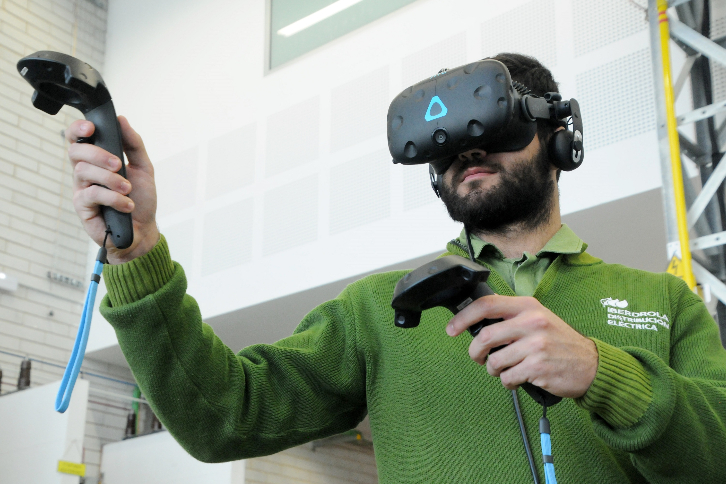Computación espacial
Fundamentos del Spatial Computing
Aunque podría parecer lo contrario, computación espacial o spatial computing no se refiere a la exploración del espacio exterior, sino más bien a la interconexión de dispositivos permitiendo interacciones con sistemas informáticos a través de gestos, movimientos oculares o con la propia voz revolucionando la forma en que interactuamos con los ordenadores.

La informática espacial, la computación espacial o el spatial computing son términos similares que se usan indistintamente para referirse a la conexión de los ordenadores con el mundo físico. Desde su origen la interección con las máquinas se ha centrado principalmente en entender como se comporta un sistema para darle instrucciones que sea capaz de interpretar. La computación espacial busca cambiar el paradigma para que las máquinas sean capaces de entender el lenguaje, el movimiento del ser humano, las expresiones y otros para interpretar el mundo real.
En lugar de utilizar dispositivos convencionales como teclados o pantallas táctiles, esta forma de computación aprovecha gestos, movimientos y comandos de voz como entradas para interactuar con sistemas digitales. Su enfoque se centra en reconocer y procesar información del entorno tridimensional, como posición, orientación e iluminación, permitiendo generar salidas adaptadas al contexto, como imágenes, sonidos o retroalimentación háptica.
Este concepto de informática espacial o spatial computing fue señalado en 2003 por Simon Greenwold, un antiguo estudiante del MIT Media Lab (EE.UU). En aquel momento parecía lejano y futurista pero en la actualidad muchas de sus ideas se han materializado gracias a avances como la inteligencia artificial (IA), los sensores de cámara y la visión por ordenador que permite rastrear entornos, personas y objetos, el Internet de las Cosas (IoT) para supervisar y controlar productos o la realidad aumentada (RA) que proporciona interfaces de usuario humanas.

Transformación digital
La digitalización es una aliada imprescindible para superar los retos en el contexto actual.

Realidad virtual
La Realidad virtual ha llegado para quedarse. Pero, ¿en qué consiste exactamente?

¿Qué es la inteligencia artificial?
La IA se basa en crear máquinas que presenten las mismas capacidades que los humanos.

'Machine Learning'
Descubre los principales beneficios del 'Machine Learning'.
Cómo funciona la informática espacial
La informática o computación espacial funciona integrando la tecnología en el entorno físico para facilitar interacciones más naturales y contextuales entre humanos y sistemas informáticos. Y hay algunos aspectos claves de cómo opera que son los siguientes:
- Sensores y captura de datos: La computación espacial se basa en la recopilación de datos del entorno mediante diversos sensores como pueden ser cámaras, sensores de movimiento, acelerómetros, giroscopios y otros dispositivos que capturan información sobre la posición, orientación, movimiento y otros aspectos del espacio tridimensional. Se ha visto evolución también en los sensores cerebrales para gestión de la interacción.
- Procesamiento de datos: Los datos capturados por estos sensores se procesan mediante algoritmos avanzados de inteligencia artificial (IA). Estos algoritmos interpretan la información, identifican patrones y generan representaciones digitales del entorno en tiempo real.
- Realidad Aumentada (RA): Otro elemento empleado a menudo por la informática espacial es la realidad aumentada que permite superponer información digital en el mundo real. Esto se logra mediante la proyección de imágenes, datos o gráficos generados por ordenador sobre la vista física del usuario, mejorando así la comprensión y la interacción con el entorno.
- Mapeo espacial: La creación de un modelo tridimensional del entorno, conocido como mapeo espacial, es esencial en la informática espacial. Este modelo permite a los sistemas comprender la disposición de objetos y su relación con el espacio circundante.
- Interacción natural: La computación espacial prioriza las interacciones naturales, como gestos, movimientos corporales y comandos de voz, en lugar de dispositivos de entrada tradicionales como pudieran ser teclados o ratones. Esto mejora la experiencia del usuario al hacer que la interacción sea más intuitiva y ajustada al comportamiento humano.
- Internet de las Cosas (IoT): La integración con el Internet de las Cosas permite la comunicación entre objetos físicos y sistemas informáticos. Los dispositivos conectados recopilan datos del entorno y se comunican entre sí para crear una red inteligente que optimiza diversas funciones.
- Automatización: En algunos casos, la informática espacial utiliza la automatización para realizar acciones específicas sin intervención humana. Esto se logra mediante la interpretación de datos y la toma de decisiones en tiempo real para ajustar configuraciones o corregir problemas automáticamente.
Un ejemplo de funcionamiento de la computación espacial se encuentra en operaciones de almacén altamente automatizadas debido a que los minoristas deben gestionar las mercancías muy rápidamente. Para ello emplean las operaciones autónomas de vehículos de guiado autónomo (AGV) que procesan constantemente datos de ubicación, ubicación relativa y velocidad para navegar por los espacios de manera eficiente y así poder cumplir con las expectativas.
Diferencias entre spatial computing y realidad virtual o realidad aumentada
El spatial computing, la realidad virtual (VR) y la realidad aumentada (AR) son conceptos relacionados pero distintos especialmente en lo que se refiere al ámbito de la interacción humano-ordenador. Mientras la informática espacial emplea gestos, movimientos y comandos de voz como entradas para los sistemas informáticos, priorizando la interacción natural, en la realidad virtual la interacción se lleva a cabo principalmente dentro del entorno virtual y los usuarios están inmersos dentro de ese mundo digital que simula la realidad. En el caso de la realidad aumentada la interacción sí ocurre en el mundo real y la información digital se encarga de complementar o mejorar esa realidad física.
Otra diferencia importante es la que tiene que ver con el enfoque de uso de estas tecnologías. La computación espacial se centra en la integración de la informática en el mundo físico, haciendo hincapié en la comprensión del espacio y la ubicación para mejorar la interacción contextual mientras que el uso de la realidad aumentada se utiliza comúnmente en juegos, simulaciones y experiencias inmersivas donde los usuarios pueden sentirse transportados a entornos virtuales y la realidad virtual está dirigida a aplicaciones comunes como navegación con indicaciones superpuestas, aplicaciones educativas y experiencias publicitarias interactivas
En resumen, el spatial computing se centra en integrar la informática en el espacio tridimensional, utilizando interacciones naturales, la realidad virtual crea entornos completamente digitales para la inmersión del usuario y la realidad aumentada superpone información digital sobre el mundo físico para mejorar la experiencia del usuario en tiempo real.
Aplicaciones de la computación espacial en proyectos de Iberdrola
Iberdrola ha implantado soluciones de computación espacial en distintos negocios pero donde mayores beneficios se obtienen es en aquellas situaciones de peligrosidad que pueden beneficiarse de emular un entorno y llevar a cabo actuaciones en un espacio virtual o mixto que sea capaz de proveer realismo y conocimiento de forma segura.
Desde renovables se han desarrollado iniciativas de formación de situaciones peligrosas, confinadas y en altura hasta el punto de que Avangrid se convirtió en un caso de negocio de Oculus del grupo Meta, por la efectividad en la implantación de realidad virtual en estas formaciones peligrosas.
Del mismo modo, en el área de redes, la coordinación en tiempo real de distintos espacios en caso de emergencia es difícil de entrenar sin estar realmente expuestos a la situación de urgencia. El equipo de redes de Avangrid han realizado proyectos que ponen una subestación en estado de alarma por una explosion del aceite de un transformación que obliga a que distintos equipos de despacho de operaciones, de personal de campo, así como de gestión de la unidades de emergencia puedan coordinarse bajo un escenario organizado.
También se ha desarrollado Wall-i, un innovador sistema de seguridad basado en la creación de muros virtuales para securizar zonas de trabajo en campo, avisando acústicamente al trabajador cuando entra en zonas de peligro que se ha delimitado previamente.
La INNOVACIÓN y la transformación digital se unen para mejorar la seguridad de las PERSONAS.
— Iberdrola (@iberdrola) January 8, 2024
👇👇👇👇
Descubre WALL-I, un sistema pionero de vigilancia y prevención con realidad aumentada con el que la #GenteIberdrola 👷♀️👷 trabajará más segura para seguir dando el mejor servici pic.twitter.com/XiJYwQrQZs




